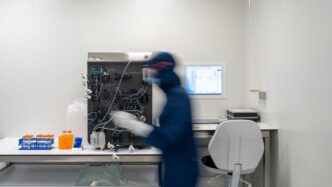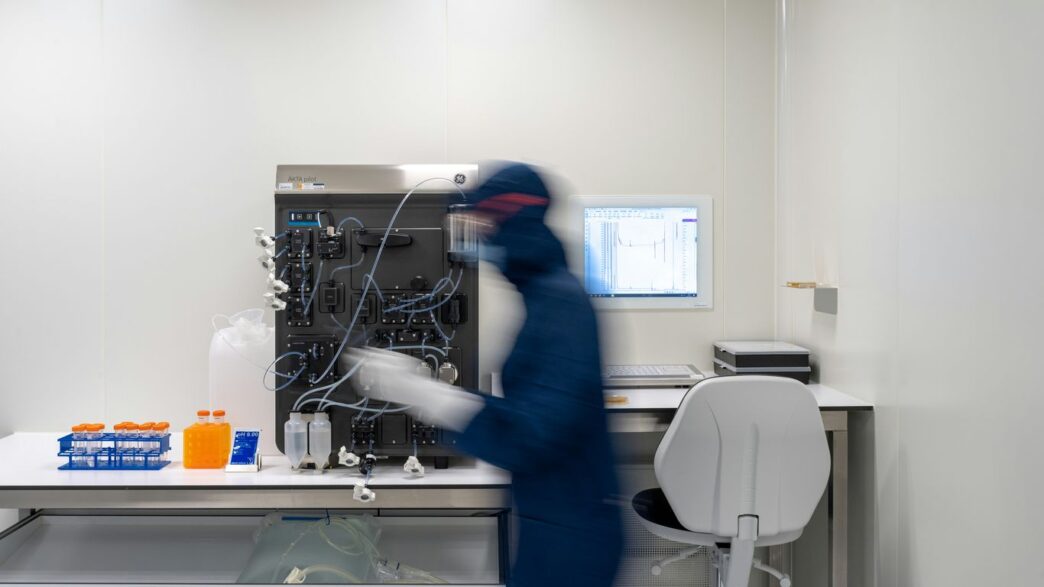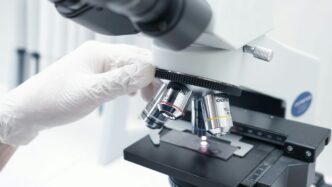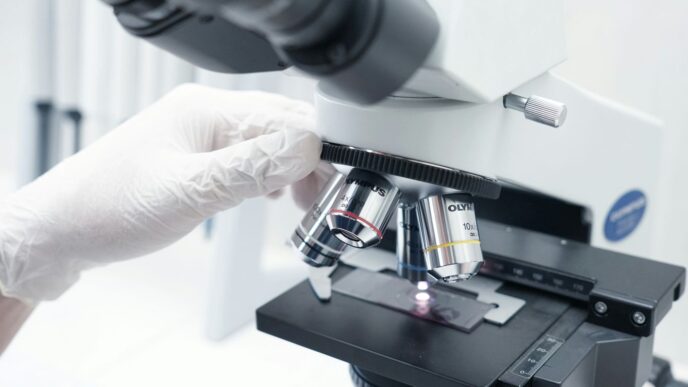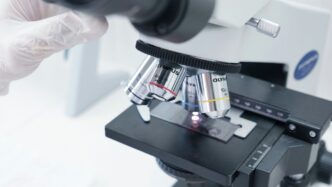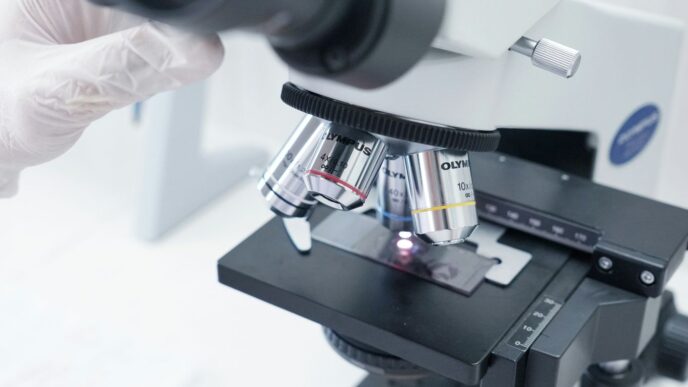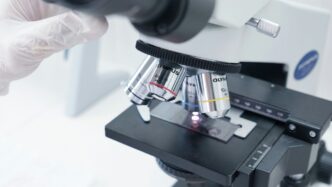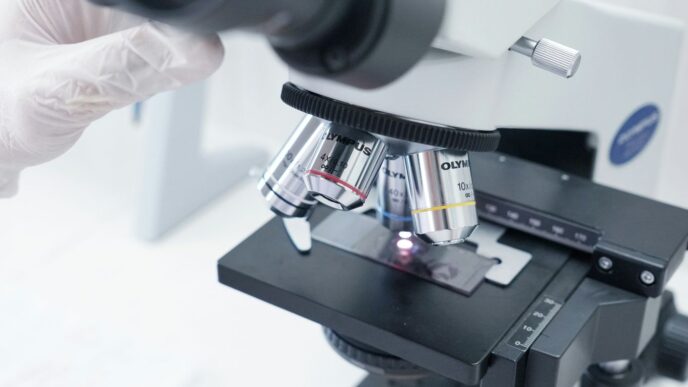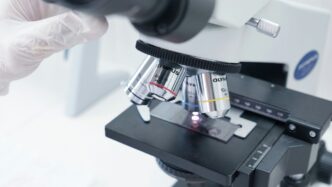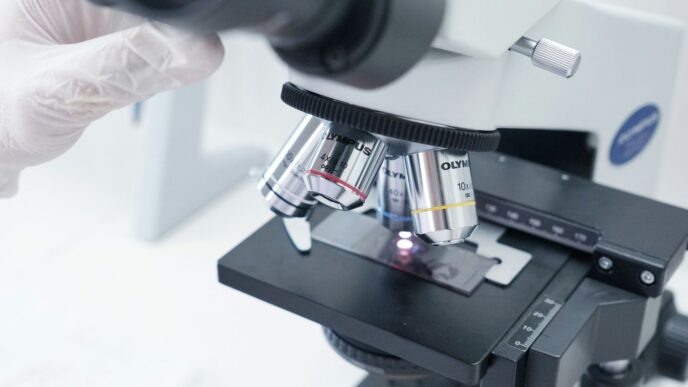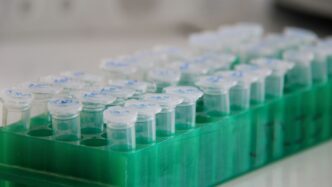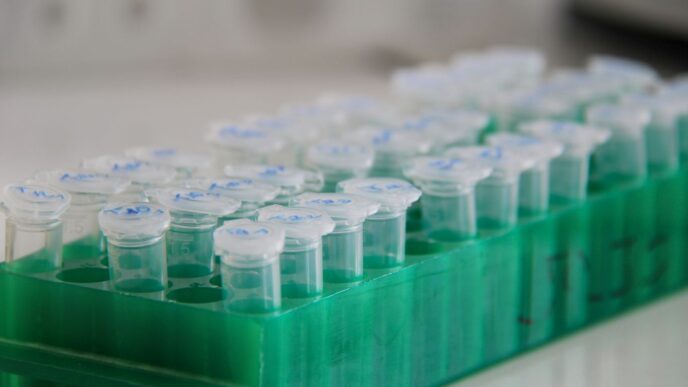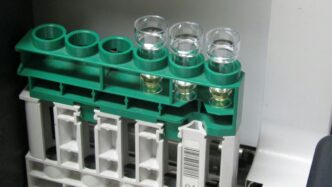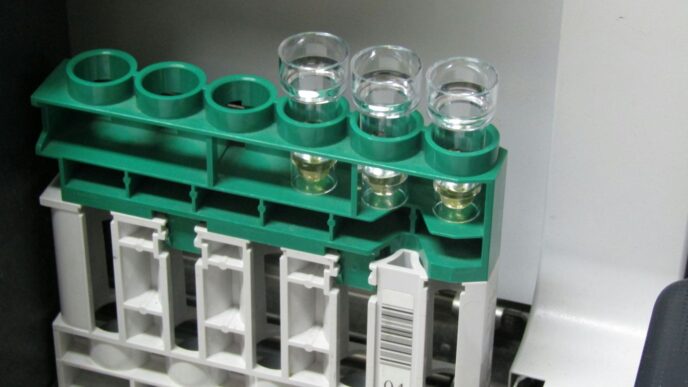So, 2025 is shaping up to be a pretty interesting year for biotech. You’ve got all these new machines coming out, and they’re really changing how things get done in the labs and factories. Think more automation, smarter systems that learn as they go, and equipment that’s easier to use and adapt. It’s all about making the whole process faster, more reliable, and frankly, more capable of handling the really cutting-edge stuff like cell and gene therapies. This guide is going to break down some of the biggest shifts you’ll be seeing in biotech machine innovation.
Key Takeaways
- Automation is getting a major upgrade, with AI stepping in to make manufacturing processes smarter and more efficient. This means fewer mistakes and better output from our biotech machine setups.
- Single-use systems are becoming the norm. They help speed things up, cut down on contamination risks, and offer more flexibility, though we still need to watch out for waste.
- Specialized biotech machine designs are crucial for advanced treatments like cell and gene therapies, needing super precise handling and ways to scale up production.
- AI isn’t just a buzzword; it’s actively being used in biotech machines to speed up drug discovery, improve how we predict diseases, and tailor treatments to individuals.
- Modern biotech machines need to be flexible and scalable. This means equipment that can easily change with production needs and support facilities making many different products.
Advancements in Automation and Data Integration for Biotech Machines
Biotech is getting smarter, and a lot of that has to do with machines that can think and talk to each other. We’re seeing a big push towards automation and better ways to handle all the data these processes generate. It’s not just about making things faster, though that’s a nice bonus. It’s really about making things more reliable and consistent.
AI-Driven Process Optimization in Biomanufacturing
Think of AI as the ultimate process engineer. It can look at mountains of data from a bioreactor or a purification run and spot patterns that a human might miss. This means it can tweak settings – like temperature, pH, or nutrient levels – in real-time to keep things running perfectly. This constant, intelligent adjustment helps boost product yield and ensures every batch is pretty much identical to the last. For example, AI can predict when a specific nutrient might run low and automatically adjust the feed, preventing a dip in cell growth. This kind of fine-tuning is a game-changer for producing complex biologics.
Real-Time Monitoring and Predictive Analytics
Gone are the days of just checking on equipment every so often. Modern biotech machines are equipped with sensors that provide a constant stream of data. This information is fed into systems that can monitor everything from cell viability to the concentration of key metabolites. But it goes further than just watching. Predictive analytics uses this data to forecast potential problems before they even happen. Imagine a system flagging a pump that’s showing early signs of wear, allowing you to schedule maintenance during a planned downtime instead of dealing with an emergency shutdown. This proactive approach significantly cuts down on unexpected interruptions and costly errors.
Here’s a look at what’s being monitored:
- Bioreactor Parameters: Temperature, pH, dissolved oxygen, CO2 levels, agitation speed, cell density.
- Downstream Processing: Flow rates, pressure, conductivity, UV absorbance, column packing integrity.
- Environmental Conditions: Room temperature, humidity, air pressure, particle counts.
Automated Bioreactor Control Systems
Bioreactors are the heart of many biomanufacturing processes, and their control systems are getting seriously sophisticated. These aren’t just simple on/off switches anymore. We’re talking about integrated systems that can manage multiple parameters simultaneously, responding to sensor feedback to maintain optimal conditions. Some advanced systems can even learn from past runs to improve future performance. This level of automation reduces the need for constant manual intervention, freeing up skilled personnel for more complex tasks and minimizing the risk of human error during critical phases of production.
The Rise of Single-Use Systems in Biotech Machine Innovation
Streamlining Bioprocessing with Disposable Technologies
Okay, so single-use systems. They’ve really become a big deal in biotech lately. Think about it – instead of cleaning and re-sterilizing equipment after every batch, you just swap it out. This cuts down on a ton of work and, importantly, reduces the risk of contamination between different products. It’s like using disposable coffee cups instead of washing a mug every single time. For places making lots of different things, this flexibility is a game-changer. It means you can switch from making one drug to another much faster without worrying about leftover bits from the old one messing things up. A lot of manufacturers are really leaning into this, with surveys showing a big jump in how many are using these disposable bioreactors and filters.
Addressing Waste Management and Reliability Concerns
Now, it’s not all sunshine and rainbows. One of the main things people talk about is the waste. All these disposable parts add up, and figuring out how to deal with that plastic and other materials in an eco-friendly way is a challenge. Companies are working on better recycling methods and designing parts that use less material. Then there’s the reliability question. Can these disposable parts really hold up over time, especially for really sensitive processes? Manufacturers are putting a lot of effort into making sure these systems are just as dependable, if not more so, than the old stainless-steel ones. They’re focusing on better materials and making sure the connections are super secure.
Precision Control in Single-Use Bioreactors and Filtration
When you’re dealing with delicate biological processes, precision is everything. Single-use bioreactors and filtration units are getting seriously sophisticated. We’re seeing better sensors and control systems built right in. This means you can monitor things like temperature, pH, and dissolved oxygen in real-time with a lot more accuracy. For filtration, it means getting exactly the right separation you need, every time. This level of control is super important for making sure the final product is consistent and effective, especially with newer, more complex therapies. It’s all about making sure that even though the equipment is disposable, the results are anything but unpredictable.
Meeting the Demands of Advanced Therapies with Specialized Biotech Machines
The biotech world is really changing, especially with new treatments like cell and gene therapies (CGT) becoming more common. These aren’t your typical drugs; they’re complex biological products that need very specific ways of being made. This means the machines used have to be pretty special too.
Ultra-Precise Handling for Cell and Gene Therapies
Making cell and gene therapies is delicate work. Think about it – you’re dealing with living cells or genetic material that can be easily damaged. So, the equipment needs to be incredibly precise. We’re talking about systems that can handle these sensitive materials without causing harm, maintaining their integrity throughout the entire process. This often involves specialized pumps and fluid handling systems that can manage very small volumes with extreme accuracy. The goal is to keep these therapies viable and effective from the lab bench all the way to the patient.
Scalable Platforms for CGT Production
One of the big hurdles with CGT has been scaling up production. Traditionally, these therapies were made in small batches, which is fine for early trials but doesn’t work for widespread use. Now, companies are developing machines and platforms that can grow with demand. This means starting with equipment that’s good for clinical trials but can also handle much larger commercial production runs without needing a complete overhaul. It’s about having systems that can adapt, so you don’t have to start from scratch when your therapy gets approved for more people.
Closed, Modular Manufacturing Systems
To keep these advanced therapies safe and prevent contamination, a lot of the manufacturing is moving towards closed systems. This means the biological material stays contained within the equipment, reducing the risk of outside contamination. Modular systems are also becoming popular. Imagine building blocks for a factory – you can add or remove modules as needed. This makes the whole setup more flexible and easier to adapt to different types of therapies or changes in production volume. It’s a more adaptable way to build and run a manufacturing facility for these cutting-edge treatments.
Leveraging Artificial Intelligence in Biotech Machine Applications

Artificial intelligence (AI) is really changing the game in biotech, making machines smarter and processes faster. It’s not just about fancy algorithms; it’s about practical tools that help us discover new drugs, figure out diseases, and even tailor treatments just for you.
Accelerating Drug Discovery and Development
Finding new medicines used to take ages. Now, AI can sift through massive amounts of biological data way faster than any human team. Think of it like a super-powered detective looking for clues in complex genetic information or chemical compounds. This speeds up finding potential drug candidates and can even help us find new uses for old drugs. Some studies suggest AI can cut down the time to get to the preclinical stage by up to 40% and save around 30% on costs. That’s a big deal for getting treatments to people sooner.
- AI algorithms analyze complex biological datasets to pinpoint potential drug targets.
- Drug repurposing becomes more efficient, finding new uses for existing medications.
- Predictive toxicology models help identify potential side effects early, reducing risks.
Enhancing Disease Prediction and Diagnostics
AI is also getting really good at spotting diseases earlier and more accurately. By looking at medical images, patient records, and genetic information, AI can find patterns that might signal a problem long before a human doctor could. This means quicker diagnoses and a better chance for successful treatment. It’s also helping to make diagnostic tools more precise, which is a win for everyone.
AI for Personalized Medicine Approaches
This is where things get really interesting. AI can look at your unique genetic makeup, lifestyle, and medical history to suggest treatments that are just right for you. Instead of a one-size-fits-all approach, AI helps create treatment plans tailored to your specific needs. This not only improves how well treatments work but also cuts down on unwanted side effects. It’s a big step towards making healthcare truly personal.
The Impact of Big Data on Biotech Machine Development
It’s pretty wild how much data is being generated in biotech these days. Think about all the "omics" stuff – genomics, proteomics, metabolomics – plus all the sensors and connected devices popping up everywhere. This mountain of information is changing how we build and use biotech machines.
Utilizing Omics Data for Innovation
This "big data" isn’t just noise; it’s a goldmine for figuring out new ways to do things. Machines are getting smarter because they can process these massive datasets. For example, analyzing genomic data helps us spot genetic markers related to diseases much faster than before. This means we can design better drugs and therapies. It’s like having a super-powered magnifying glass for biology.
Improving Clinical Trial Recruitment
Clinical trials can be a real bottleneck in getting new treatments to people. Big data helps here too. By analyzing patient data, we can identify and recruit the right people for trials more effectively. This speeds things up and makes sure the trials are set up to give us the clearest results possible. Machines that can sift through patient records and match them to trial criteria are becoming incredibly important.
Bioinformatics Solutions for Crop and Livestock Improvement
It’s not just about human health, either. Biotech machines are also being used to improve agriculture. Bioinformatics tools, powered by big data, help us develop better animal breeds and more resilient crops. We can analyze genetic information to create livestock that are healthier or crops that can withstand tough conditions. It’s all about making smarter choices based on the data we have.
Flexibility and Scalability in Modern Biotech Machines
Biotech manufacturing is changing fast. Companies need machines that can keep up, whether production needs suddenly jump or drop. It’s not just about making one thing anymore; many facilities now handle different products. This means equipment has to be adaptable.
Adapting to Shifting Production Demands
Think about it like this: one day you might need to produce a lot of one drug, and the next, you might need a smaller batch of something else entirely. Old-school, fixed systems just can’t handle that kind of quick change. Modern biotech machines are designed with flexibility in mind. They can be reconfigured or adjusted more easily to meet these fluctuating needs. This adaptability helps avoid costly downtime and keeps production flowing smoothly, no matter what the market throws at you.
Modular and Scalable Production Equipment
This is where modularity really shines. Instead of buying one giant, specialized machine, companies are opting for systems made of smaller, independent units. You can add or remove these modules as needed. Need more capacity? Just add more modules. Need to switch to a different process? Swap out a few modules. It’s like building with high-tech LEGOs for your lab. This approach makes it much easier to scale up or down without a massive overhaul. A recent report showed that a good chunk of biotech firms are investing in this kind of equipment because it just makes good business sense.
Supporting Multi-Product Facilities and Decentralized Manufacturing
Having machines that can handle multiple products is a big deal, especially for companies that don’t focus on just one therapy. It means less time and money spent on cleaning and retooling between batches. Plus, with the push for decentralized manufacturing – making drugs closer to where they’re needed – flexible and scalable equipment is key. It allows for smaller, more localized production sites that can still ramp up or down as required. This distributed approach can also improve supply chain resilience, making sure medicines are available even if one location faces issues.
Looking Ahead
So, what does all this mean for the future? Basically, biotech machines are getting smarter and more adaptable. We’re seeing a big push towards automation and using data to make things run smoother, which should cut down on mistakes and speed things up. Plus, with new treatments like cell and gene therapies becoming more common, the equipment needs to be super precise and flexible. It’s a lot to keep up with, but companies that focus on these new technologies and work together are the ones that will really lead the way in making new medical breakthroughs happen. It’s going to be an interesting few years.
Frequently Asked Questions
What’s new with machines in biotech for 2025?
In 2025, biotech machines are getting smarter and more connected. Think of machines that can run by themselves more, learn from data to do a better job, and connect easily with other systems. This means faster and more reliable production of medicines and other important stuff.
Are disposable parts becoming more common in biotech machines?
Yes, absolutely! Using parts that can be thrown away after one use is a big trend. These ‘single-use’ parts help keep things clean, make it easier to switch between making different products, and save time because you don’t have to clean old parts as much.
How are machines changing to help with new kinds of treatments like gene therapy?
New treatments, like those using genes or cells, need super careful handling. So, machines are being made to be incredibly precise. They’re also designed to be flexible, allowing scientists to make small batches for testing and then easily make bigger batches if the treatment works well.
How is artificial intelligence (AI) being used in biotech machines?
AI is like a super-smart assistant for biotech machines. It helps speed up finding new medicines, makes machines work better by learning from mistakes, and even helps doctors figure out diseases faster or create treatments just for you.
What does ‘big data’ mean for biotech machines?
Biotech creates tons of information, like from studying genes or patient health. ‘Big data’ means using all this information to make machines and processes better. It helps find new drugs, improve how we test medicines, and even make better crops or farm animals.
Why is flexibility important for biotech machines?
Biotech companies need machines that can change what they’re doing quickly. Maybe they need to make more of one medicine or switch to a completely different one. Flexible and ‘scalable’ machines can adjust to these changes, helping companies keep up with what’s needed without wasting time or money.

